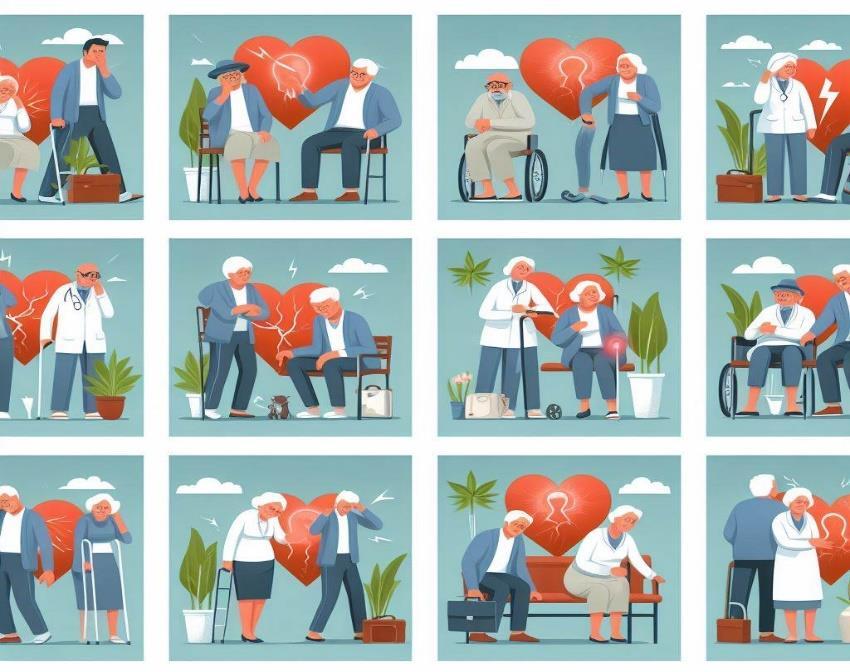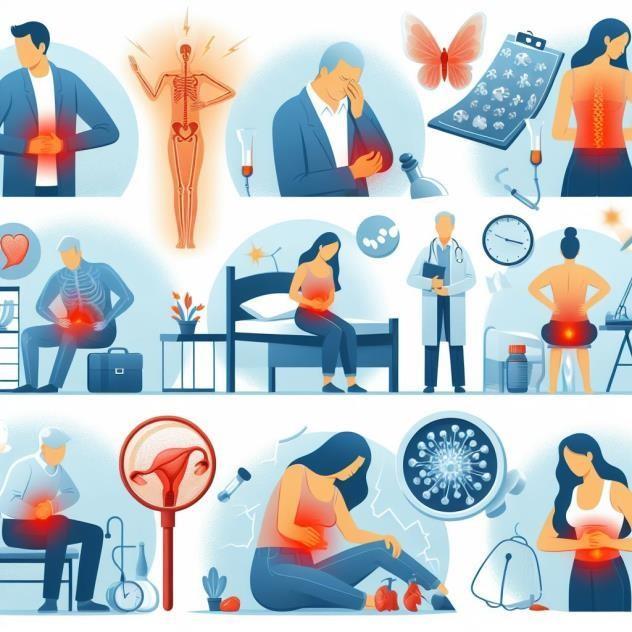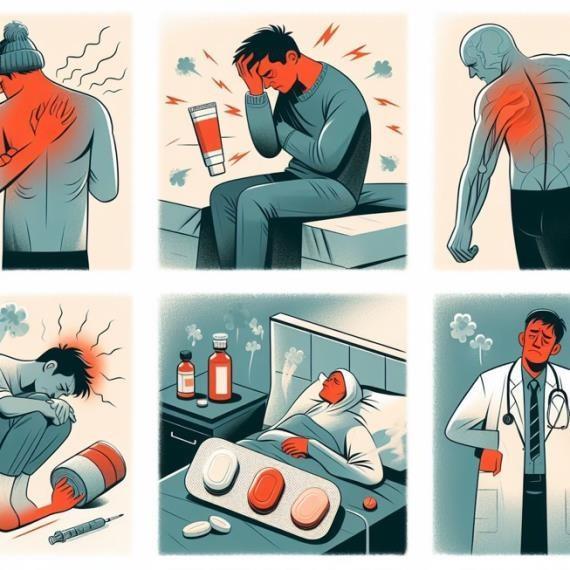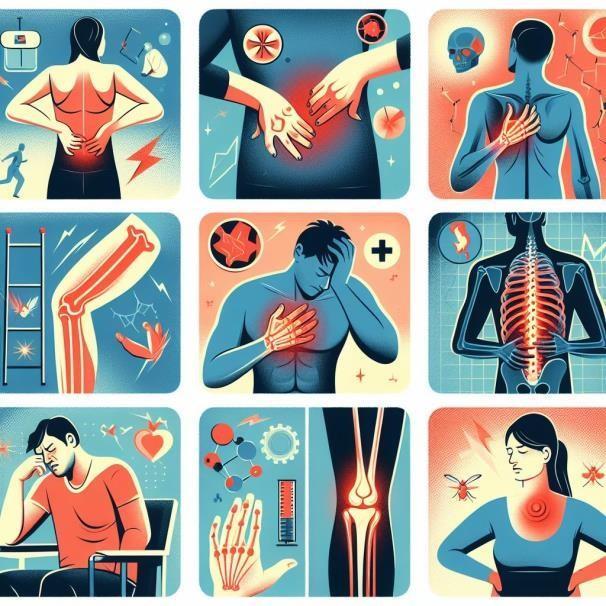What is Chronic Pain: Causes, Symptoms, and Relief Treatment Options

Introduction
Chronic pain is a complex and pervasive medical condition that affects millions of individualsworldwide, significantly impactingtheir quality oflifeand overallwell-being. Chronic pain is characterized by persistent discomfort that lasts for an extended period,typically exceeding three to six months. Unlike acute pain, which serves as a warning signal of injury or illness and usually resolves as the body heals, chronic pain persists long after the initial injury has healed. It can affect various parts of the body and may stem from a wide range of underlying causes, including nerve damage, inflammation, or dysfunction in the central nervous system. It may significantly impact an individual's physical and emotional well-being, as well astheir daily activities and quality of life.
Managing chronic pain effectively often requires a multidisciplinary approach involvingmedical intervention, lifestyle modifications, and psychological support to improve theindividual's quality oflifeand overallwell-being.
What is chronic pain?
Chronic Pain can manifest in various forms, including dull aches, sharp stabbing sensations, or throbbing discomfort, and may affect different parts of the body, such asthemuscles,joints,or nerves.
The causes of chronic pain are diverse and can stem from a range of underlyingconditions, including injuries, nerve damage, inflammatory disorders, or chronic illnesses like arthritis or fibromyalgia. Additionally, psychological factors such as stress,anxiety, or depression can exacerbate and prolong chronic pain symptoms.
Managing chronic pain effectively often requires a comprehensive and multidisciplinary approach. This approach may include medical interventions such as medications, physical therapy, or surgical procedures, along with lifestyle modifications, such as exercise, nutrition, and stress management techniques. Furthermore, addressing the emotional and psychological aspects of chronic pain through counseling, cognitive-behavioral therapy or relaxation techniques is essential for improving the individual'squality of life and restoring their ability to function optimally
Here are some general examples of the Chronic Pain:
1. Back Pain: Persistent pain in the lower or upper back, which can be caused by various factors such as injury, muscle strain, or underlying medical conditions like arthritis or spinal disc problems.
2. Arthritis: Conditions such as osteoarthritis, rheumatoid arthritis, or psoriatic arthritis cause chronic joint pain and inflammation.
3. Fibromyalgia: A disorder characterized by widespread musculoskeletal pain, fatigue, sleep disturbances, and tenderness in specific areas of the body.
4. Neuropathic Pain: Resulting from damage or malfunction of the nervous system, neuropathic pain can be caused by conditions like diabetic neuropathy, trigeminal neuralgia, or postherpetic neuralgia.
5. Migraines: Recurring severe headaches often accompanied by symptoms like nausea, sensitivity to light and sound, and visual disturbances.
6. Chronic Fatigue Syndrome (CFS): Although primarily associated with fatigue, CFS can also involve chronic pain, headaches, and other symptoms.
7. Endometriosis: A condition where tissue similar to the lining of the uterus grows outside the uterus, causing chronic pelvic pain, especially during menstruation.
8. Interstitial Cystitis/Bladder Pain Syndrome (IC/BPS): A chronic condition characterized by bladder pain, urinary urgency, and frequency.
9. Chronic Pelvic Pain Syndrome (CPPS): Persistent pain in the pelvic region, often associated with conditions like chronic prostatitis in men or pelvic floor dysfunction in both men and women.
10. Complex Regional Pain Syndrome (CRPS): A rare chronic pain condition characterized by severe, continuous pain, usually affecting an arm or a leg, which may be triggered by injury or trauma.
What are the causes of chronic pain?
Chronic pain can arise from a myriad of underlying causes, each contributing to the persistence of discomfort and impairment. Musculoskeletal conditions such as osteoarthritis, rheumatoid arthritis, fibromyalgia, and chronic back pain are among themost common culprits of chronic pain. These conditions often involve inflammation, joint degeneration, or muscle dysfunction, leading to persistent pain that can be debilitating.
Causes of Chronic Painin Elderly People:
1. Degenerative Conditions: Conditions such as osteoarthritis, spinal stenosis, and degenerative disc disease are common in elderly individuals and can lead tochronicjoint and backpain.
2. Neuropathic Pain: Neuropathic disorders characterized by nerve damage, such as diabetic neuropathy, postherpetic neuralgia (resulting from shingles), or chemotherapyinduced neuropathy, can cause chronic neuropathic pain. This type of pain is often described as burning, tingling, shooting, or electric shock-like sensations, reflecting the underlying nerve dysfunction.
3. Inflammatory Disorders: Chronic inflammatory conditionssuch asrheumatoid arthritis, polymyalgia rheumatica, or giant cell arteritis can cause persistent paininelderly individuals.

4. Fractures and Trauma: Previous fractures or injuries that have not fully healedcan lead to chronic pain, particularly in theelderly population.
5. Cancer: Elderly individuals may experience chronic pain due to cancerous tumors, metastasis, or cancer treatments such as radiation or chemotherapy.
CausesofChronicPainin Young Adults:
1. Musculoskeletal Injuries: Sports injuries, accidents, or repetitive strain injuriescan lead to chronic musculoskeletal pain in young adults.
2. Chronic Illnesses: Chronic illnessessuch as cancer, multiple sclerosis, inflammatory bowel disease, or sicklecell anaemia can create chronic pain due to tissue damage, inflammation, or nerve dysfunction associated with these conditions.
3. Psychological Factors: Psychological factors play a significant role in the experience of chronic pain. Conditionssuchasanxiety, depression, stress, or past trauma can exacerbate pain through mechanisms such as central sensitization, altering pain perception and processing. The bidirectional relationship between chronic pain and mental health underscoresthe importance of addressing psychological factors in pain management.

4. Autoimmune Disorders: Conditions like lupus, multiple sclerosis, or ankylosing spondylitis can cause chronic pain in young adults by affecting the immune systemand causinginflammationand tissuedamage.
5. GeneticFactors: CertaingeneticconditionssuchasEhlers-Danlossyndrome orsickle cell disease can predispose young adults to chronic pain due to abnormalities in connective tissue or blood cells.
Understanding the specific underlying causes of chronic pain in both elderly and youngadult populations is crucial for developing targeted treatment plans and improving patient outcomes.
What are the symptoms of chronic pain ?
Chronic pain manifests in a variety of ways and can affect individuals differently basedon the underlying condition causing the pain and other factors such as age, lifestyle, and overall health. Common symptoms of chronic pain include:
1. Persistent Pain: Chronic pain is characterized by persistent discomfort that lasts for an extended period, typically exceeding three to six months. The pain may vary in intensity, ranging from mild to severe, and can be constant or intermittent. This persistent discomfort can significantly impair an individual'sability to perform daily activities and negatively impact their quality of life.
2. Localized or Radiating Pain: Chronic pain may be localizedto a specific area of thebody, such as the lower back, neck,joints, or muscles. Alternatively, it can radiate to other regions, leading to referred painthat isperceived in areas distant from the source of thepain.

3. Variety of Sensations: Chronic paincanmanifest assharp, stabbing, dull, aching,throbbing, or burning sensations, depending on the underlying cause and individual factors. The quality and intensity of pain mayfluctuateover time, further complicating its management.
4. Reduced Mobility and Function: Chronic pain often leads to stiffness, muscletension, reduced rangeofmotion, and difficulty performing daily activities. Individuals may experience limitations in mobility and functionality, impactingtheirability towork, exercise, orengagein social activities.
5. Fatigue and Sleep Disturbances: Chronic pain can cause fatigue, exhaustion, and disruptions in sleep patterns, including difficulty falling asleep, staying asleep, or experiencing restorative sleep. Poor sleep quality can exacerbate painand diminish overall well-being, creating a vicious cycle of pain and sleep disturbances.
6. Emotional and Psychological Impact: Chronic pain can significantly affect mental health, leading to symptoms of anxiety, depression, irritability, mood swings, and social withdrawal. The persistent nature of pain can disrupt daily life,relationships, and overall quality oflife.
7. Cognitive Impairment: Chronic pain may impair cognitive function, including difficulties with concentration, memory, decision-making, and problem-solving. These cognitive symptoms can further impact daily functioning and contribute toemotional distress.
8. OtherPhysicalSymptoms: Chronicpainmaybeaccompanied by otherphysical symptoms such as headaches, nausea, dizziness, weakness, numbness, tingling, or changes in appetite and weight.
Overall, chronic pain is a multifaceted and complex condition that can have profound physical, emotional, and psychological effects on individuals. Effective management and treatment often require a comprehensive approach tailored to address the specificsymptomsand underlying causesofchronicpain.
What are the treatmentoptions forChronic pain?
Treatment options for chronic pain vary depending on the underlying cause, severity of symptoms, and individual preferences. Both allopathic (conventional) andalternative medicine approaches can be used to manage chronic pain effectively.
Allopathic Treatments:
1. Medications: Allopathic treatments often involve the use of pain-relieving medications, including nonsteroidal anti-inflammatory drugs (NSAIDs), acetaminophen, opioids (for severe pain), antidepressants, anticonvulsants, andmuscle relaxants.
2. Physical Therapy: Physical therapy focuses on improving strength, flexibility,and function through exercises, manual therapy techniques, and modalities such as heat, ice, ultrasound, and electrical stimulation.
3. Interventional Procedures: Invasive procedures such as nerve blocks, steroid injections, radiofrequency ablation, or spinal cord stimulation may be used totarget specific nerves or areasof pain and provide relief.
4. Surgery: In some cases, surgical interventions may be recommended to address underlying structural issues contributing to chronic pain, such as herniated discs, spinal stenosis, or joint degeneration.
5. Psychological Therapy: Cognitive-behavioral therapy (CBT), counselling, orother forms of psychotherapy can help individuals cope with pain, manage stress, address negative thought patterns, and improve overall well-being.
Alternative Medicine Treatments:
1. Acupuncture: Acupuncture involves the insertion of thin needles into specificpoints on the body to stimulate nerve pathways and promote pain relief, relaxation, and healing.
2. Chiropractic Care: Chiropractic adjustments, spinal manipulation, and manualtherapies are used to improve spinal alignment, reduce joint dysfunction, and alleviate pain associated with musculoskeletal conditions.
3. MassageTherapy: Massagetherapy can help reduce muscle tension, improve circulation, promote relaxation, and alleviate pain associated with soft tissue injuries or chronic conditions like fibromyalgia.
4. Herbal Remedies and Supplements: Certain herbal remedies and dietary supplements, such as turmeric, ginger, omega-3 fatty acids, and glucosamine, may have antiinflammatory or analgesicproperties and can be used to manage chronic pain.

5. Mind-Body Practices: Mindfulness meditation, yoga, tai chi, and relaxation techniques can help individuals cultivate awareness, reduce stress, improvecoping skills, and enhance pain tolerance.
6. Biofeedback: Biofeedback techniques use electronic monitoring devices to help individuals learn to control physiological responses such as heart rate, muscle tension, and skin temperature, which can influence pain perception.
7. Nutritional Therapy: A balanced diet rich in anti-inflammatory foods, adequate hydration, and nutritional supplements (e.g., vitamin D, magnesium) may support overall health and reduce inflammation associated with chronic pain conditions.
8. Music Therapy: Listening to music, playing musical instruments, or engaging increative expression through music can promote relaxation, reduce anxiety, and distract from painsensations.
Individuals with chronic pain need to work closely with healthcare professionals to develop a personalized treatment plan that addresses their specific needs, preferences,and goals. Integrating a combination of allopathic and alternative medicine approaches can often provide the most comprehensive and effective management of chronic pain.
How does CureEZ Help in Pain Relief?
At CureEZ, we understand the challenges individuals face in managing chronic pain, and we're dedicated to providing comprehensive and compassionate care in the comfort of your own home. Through our trusted network of partners, weoffer arange ofevidence-based treatments and therapies tailored to meet your unique needs.
Our chronic pain management services include:
1. Pain Assessment:Ourexperienced healthcareprofessionalsconduct thorough assessments to understand the underlying causes and severity of your chronic pain.
2. Medication Management: We work closely with your healthcare team to ensureoptimal medication management, including prescription refills, dosage adjustments, and monitoring for potential side effects.
3. Physical Therapy: Our skilled physical therapists develop personalized exerciseprograms to improve strength, flexibility, and mobility, reducing pain and enhancingoverall function.
4. Psychological Support: Chronic pain can take a toll on mental health. Our compassionatecounselorsprovidesupport,copingstrategies,and mindfulness techniques to help you manage stress, anxiety, and depression associated with chronic pain.
5. Alternative Therapies: We offer access to a variety of alternative therapies suchas acupuncture, massage therapy, chiropractic care, and biofeedback to complement traditional treatments and alleviate pain.
6. Nutritional Counseling: Proper nutrition plays a crucial role in managing chronic pain. Our registered dietitians provide guidance on anti-inflammatory diets, supplementation, and lifestyle modifications to support your overall well-being.
7. Remote Monitoring: Through our innovative telehealth platform, we offer remote monitoring services to track your progress, monitor vital signs, and provide real-time support from healthcare professionals.
With CureEZ, you can rest assured that you're receiving high-quality care in the comfort of your own home. We prioritize convenience, accessibility, and patient-centred care, ensuring that you have the support you need to manage your chronic pain effectively. If hospital-based care is necessary, we facilitate seamless transitions and coordinate withour partner hospitals to ensure continuity ofcare.
Take the first step towards better pain management with CureEZ. Let us help youreclaimyourlife from chronic pain."
References
https://my.clevelandclinic.org/health/diseases/4798-chronic-pain
https://www.forbes.com/health/conditions/chronic-pain/
